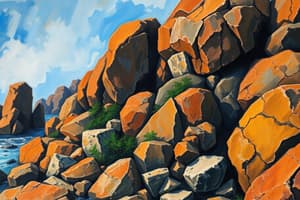Podcast
Questions and Answers
What characterizes intrusive igneous rocks?
What characterizes intrusive igneous rocks?
- They form large crystals due to slow cooling beneath the surface. (correct)
- They derive from the accumulation of sediments.
- They have small or no visible crystals.
- They cool rapidly on or above the Earth's surface.
Which of the following is an example of a detrital sedimentary rock?
Which of the following is an example of a detrital sedimentary rock?
- Coal
- Shale (correct)
- Limestone
- Rock salt
What is the main factor influencing the size of crystals in igneous rocks?
What is the main factor influencing the size of crystals in igneous rocks?
- Depth of mineral deposits
- Particle size of sediments
- Cooling rate of the magma or lava (correct)
- Temperature of the surrounding environment
Which type of metamorphism occurs over large areas due to tectonic movements?
Which type of metamorphism occurs over large areas due to tectonic movements?
Which igneous rock is an example of an extrusive rock?
Which igneous rock is an example of an extrusive rock?
What distinguishes foliated metamorphic rocks from non-foliated ones?
What distinguishes foliated metamorphic rocks from non-foliated ones?
What type of sedimentary rock is formed from the precipitation of minerals from solution?
What type of sedimentary rock is formed from the precipitation of minerals from solution?
What is meant by 'metamorphic grade'?
What is meant by 'metamorphic grade'?
Flashcards
Igneous Rocks
Igneous Rocks
Rocks formed from cooled and solidified magma or lava.
Intrusive Igneous Rocks
Intrusive Igneous Rocks
Igneous rocks that cool slowly beneath Earth's surface, creating large crystals.
Extrusive Igneous Rocks
Extrusive Igneous Rocks
Igneous rocks that cool quickly on or above the surface, usually with small or no crystals.
Sedimentary Rocks
Sedimentary Rocks
Signup and view all the flashcards
Detrital Sedimentary Rocks
Detrital Sedimentary Rocks
Signup and view all the flashcards
Metamorphic Rocks
Metamorphic Rocks
Signup and view all the flashcards
Foliated Metamorphic Rocks
Foliated Metamorphic Rocks
Signup and view all the flashcards
Metamorphic Grade
Metamorphic Grade
Signup and view all the flashcards
Study Notes
Igneous Rocks
- Formed from the cooling and solidification of magma or lava.
- Classified based on their mineral composition and texture.
- Intrusive igneous rocks (plutonic): Cool slowly beneath the Earth's surface, resulting in large crystals. Examples include granite and diorite.
- Extrusive igneous rocks (volcanic): Cool rapidly on or above the Earth's surface, resulting in small or no visible crystals. Examples include basalt and obsidian.
- Factors influencing crystal size include cooling rate, pressure, and the presence of dissolved gases.
- Composition is determined by the minerals present in the magma (e.g., silica content).
- Common igneous rock-forming minerals include quartz, feldspar, mica, and amphibole.
Sedimentary Rocks
- Formed from the accumulation and cementation of sediments.
- Classified based on their origin (e.g., detrital, chemical, organic).
- Detrital sedimentary rocks: Composed of fragments of pre-existing rocks (clasts). Examples include sandstone, shale, and conglomerate. Grain size, sorting, and shape are key characteristics.
- Chemical sedimentary rocks: Formed from the precipitation of minerals from solution. Examples include limestone, dolomite, and rock salt. Often form in evaporative environments.
- Organic sedimentary rocks: Formed from the accumulation and compression of organic material. Examples include coal and some types of limestone.
Metamorphic Rocks
- Formed from pre-existing rocks (protoliths) that have been changed by heat, pressure, and/or chemical reactions.
- Classified based on their texture and mineral composition.
- Contact metamorphism: Occurs when pre-existing rocks are heated by an igneous intrusion.
- Regional metamorphism: Occurs over large areas due to tectonic plate movements and the associated pressure and temperature changes.
- Foliated metamorphic rocks: Exhibit a layered or banded texture due to the alignment of minerals under pressure. Examples include slate, schist, and gneiss.
- Non-foliated metamorphic rocks: Do not have a layered texture. Examples include marble, quartzite.
- Metamorphic grade refers to the intensity of the metamorphism, which is determined by the temperature and pressure conditions.
- Changes in mineral assemblages and textures reveal information about the metamorphic history of a rock.
Studying That Suits You
Use AI to generate personalized quizzes and flashcards to suit your learning preferences.
Description
This quiz provides an overview of igneous and sedimentary rocks, discussing their formation processes, classifications, and key characteristics. Explore the differences between intrusive and extrusive igneous rocks and learn about the origins of sedimentary rocks, including detrital, chemical, and organic types.




